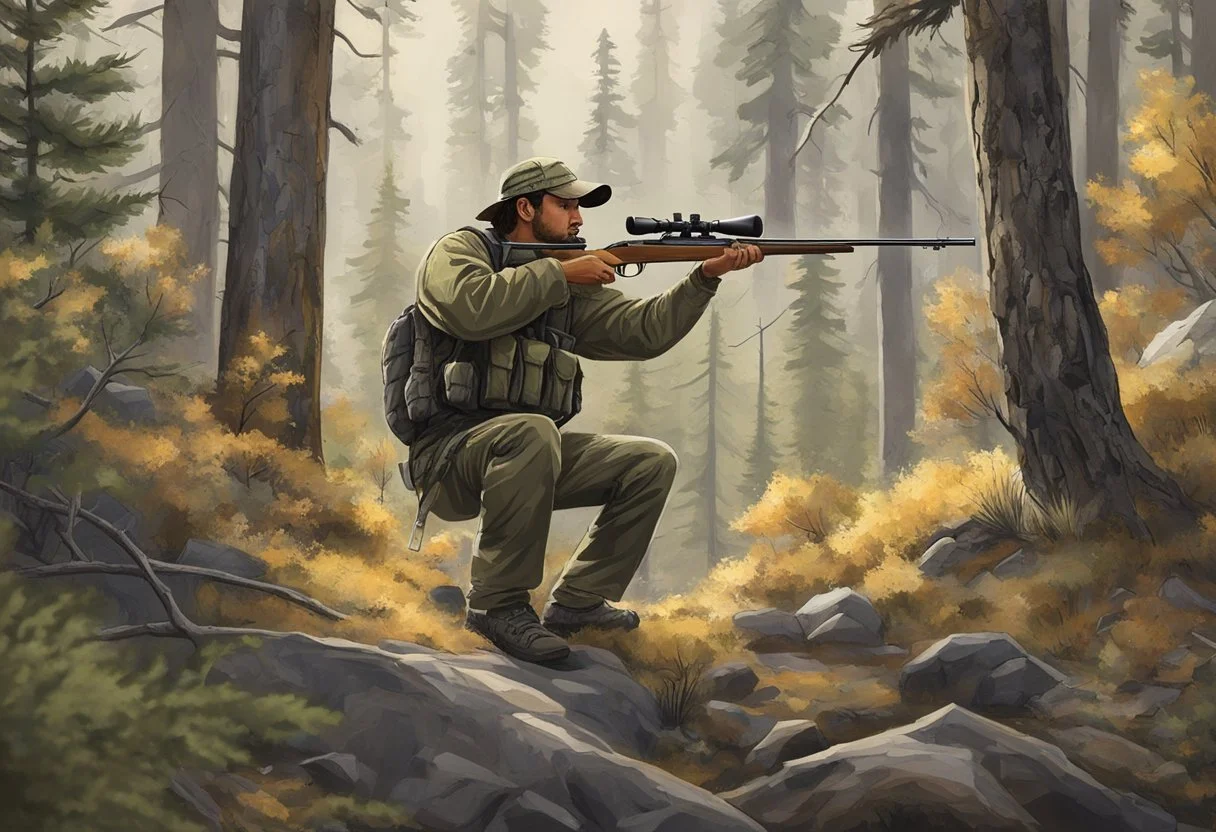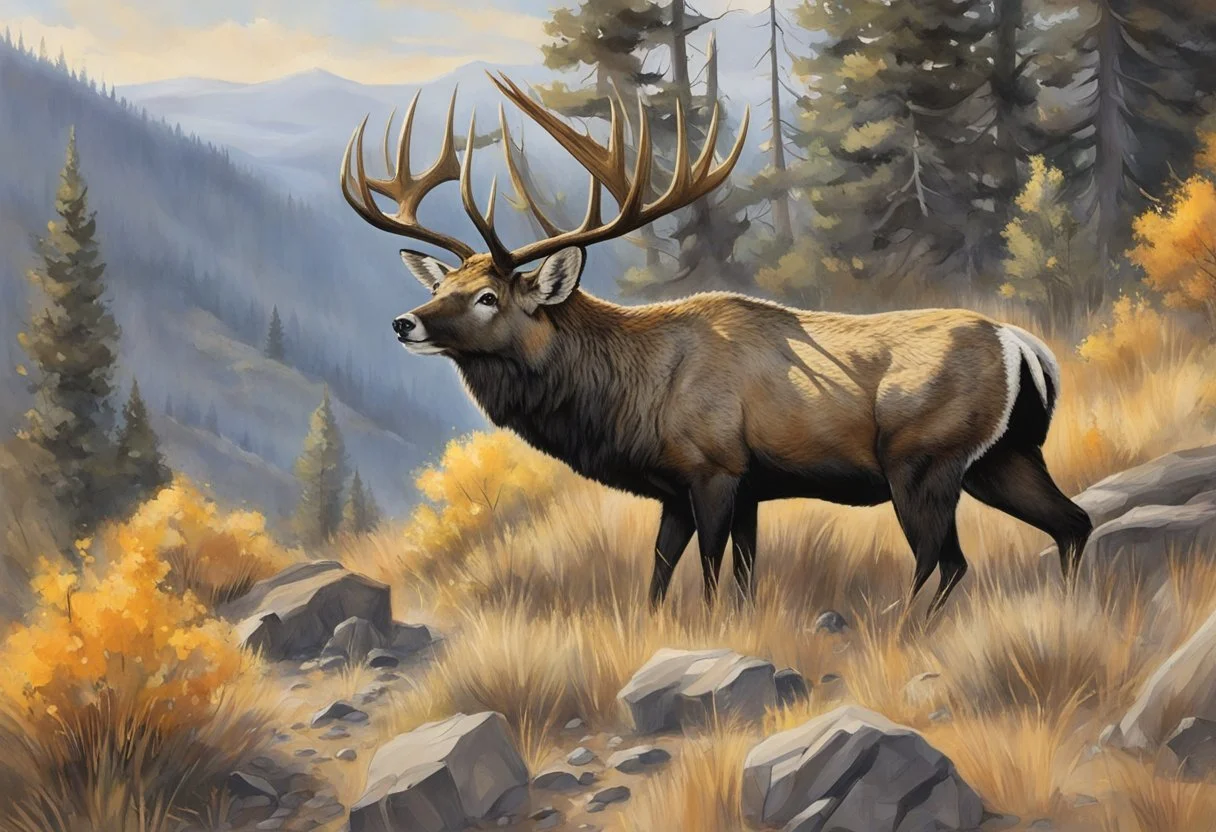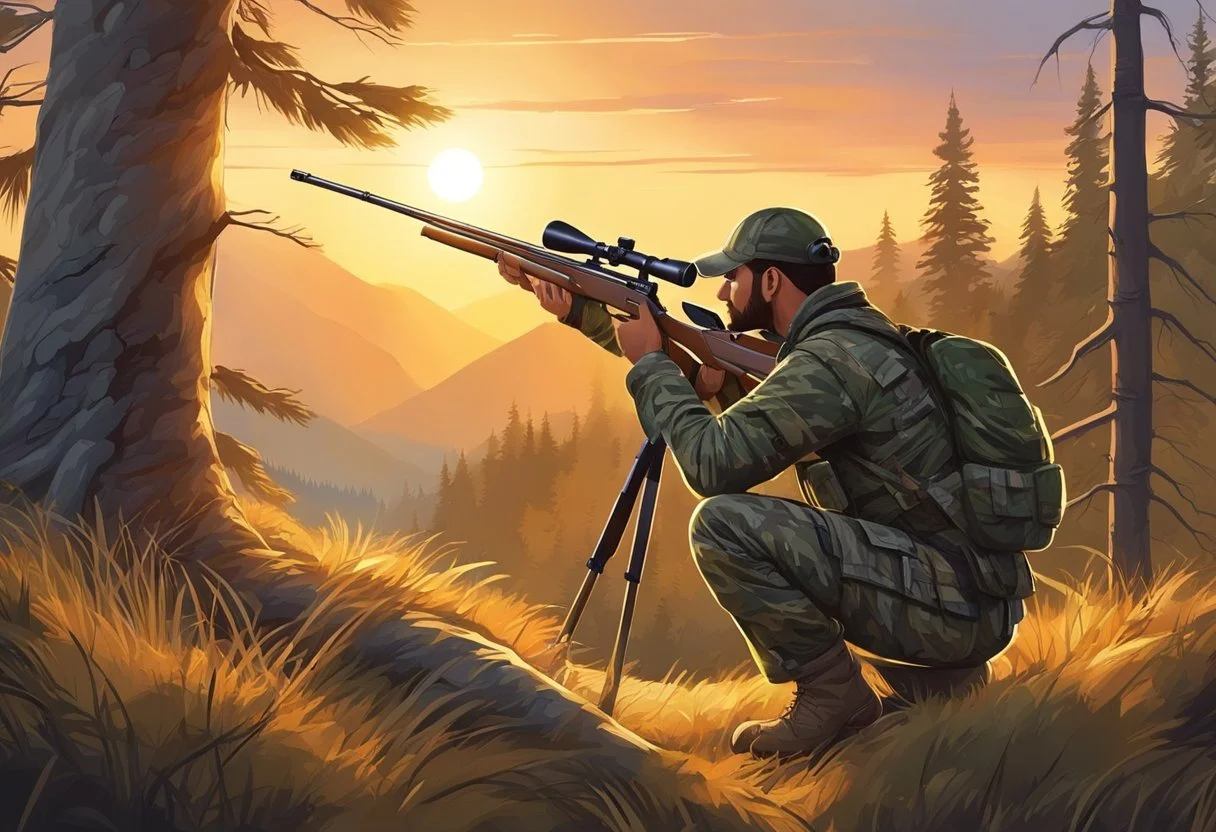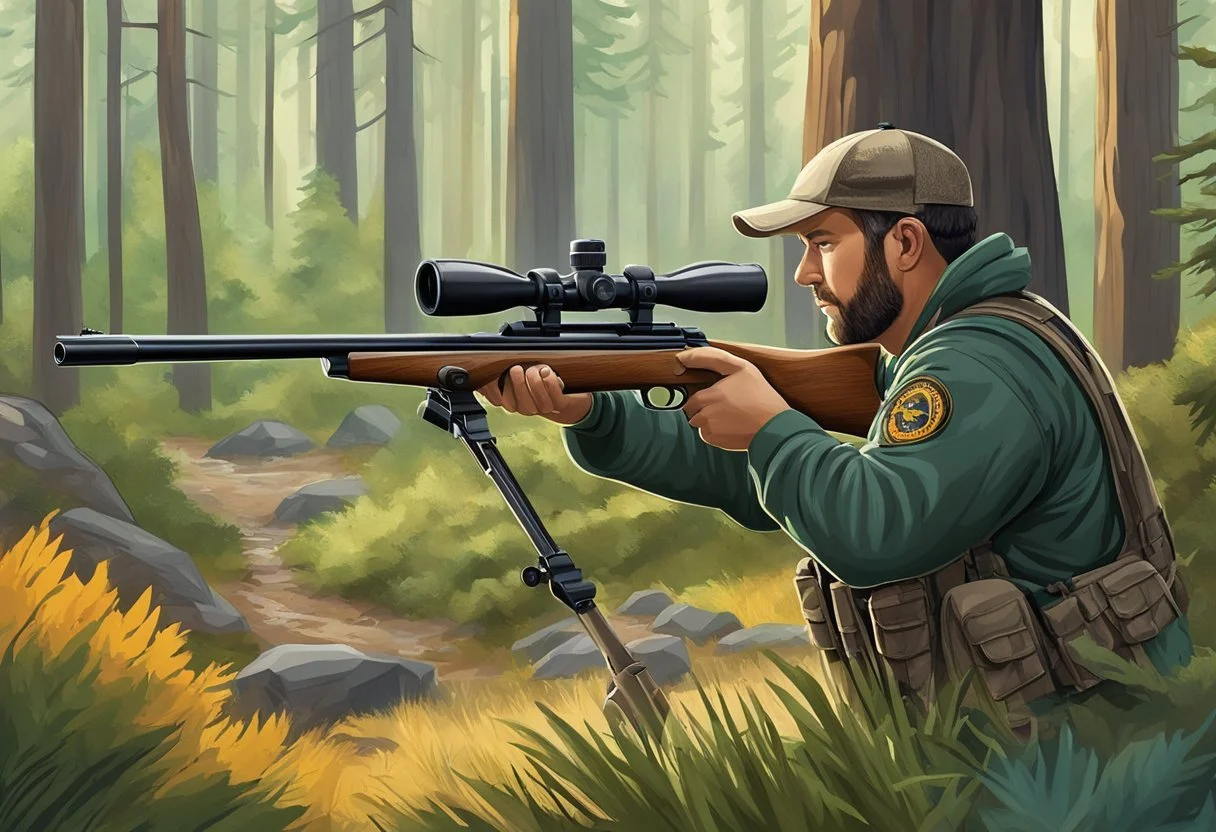Your Guide to Hunting in Idaho
Essential Tips and Guide
This Article is Part of Our Hunting Guide for All 50 US-States
The expansive wilderness of Idaho offers an ideal setting for both experienced hunters and beginners alike. With its vast forests, numerous mountain ranges, and freshwater resources, Idaho is a must-visit destination for those looking to dive into the exciting world of hunting. For beginners, the state presents an excellent opportunity to develop skills and familiarize yourself with the intricacies of hunting, while learning to appreciate the natural beauty and wildlife that surrounds you.
Idaho's hunting seasons cater to a wide range of species and interests, from big game such as deer, elk, and moose, to smaller quarry like waterfowl, upland game birds, and even predatory animals such as coyotes and wolves. To ensure a successful and enjoyable hunting experience, it's vital for beginners to familiarize themselves with the state's hunting regulations, obtain appropriate hunting licenses, and educate themselves on ethical practices and wildlife conservation measures.
Preparing for a hunting trip in Idaho involves learning about the various hunting regions, acquiring essential gear, and developing an understanding of the game you wish to pursue. As a beginner, partnering with an experienced mentor or joining a hunting group can greatly enhance your overall experience, providing valuable guidance and assistance in navigating the unique terrain and diverse wildlife that Idaho has to offer. With dedication and proper preparation, beginners can embark on an unforgettable hunting adventure amidst the natural splendor of Idaho's wilderness.
Understanding Hunting Licenses in Idaho
Types of Hunting Licenses
In Idaho, there are several types of hunting licenses available to both residents and non-residents. Here is a list of the most common licenses offered:
Resident Licenses: These are available to individuals who have been living in Idaho for at least 6 months. They include General Hunting, Combination Hunting and Fishing, and Junior Hunting licenses.
Non-resident Licenses: Non-residents can purchase General Hunting, Combination Hunting and Fishing, and Small Game Hunting licenses.
Youth Licenses: Special licenses are available for young hunters under the age of 18. These include the Junior Hunting License for residents and the Youth Small Game Hunting License for non-residents.
How to Obtain a Hunting License
To secure a hunting license in Idaho, you can visit any one of the authorized license vendors throughout the state, such as sporting goods stores and other retailers. Additionally, licenses can be obtained online through Idaho Department of Fish and Game's website. In both cases, proof of residency and identification will be required.
Hunting Passport Program
If you are new to hunting or introducing someone to the sport, consider participating in the Hunting Passport Program. This unique program allows first-time hunters aged 8 and up to try hunting for one year without needing to complete a hunter education course. Hunting Passport holders must be accompanied by a licensed hunter who is at least 18 years old. This program is available to Idaho residents and non-residents alike.
Hunter Education Requirements
Before purchasing a hunting license in Idaho, hunters born on or after January 1, 1975, must complete a hunter education course. This course teaches hunting safety, ethics, and wildlife conservation. Various course formats are available, including traditional classroom sessions, online, and hands-on field days. Upon successful completion, a Hunter Education Certificate will be issued, which is required when applying for a hunting license.
Wildlife and Game Species
Big Game Targets
Idaho is home to a wide array of big game species that attract hunters from all over the country. Some of the most popular big game animals include elk, mule deer, white-tailed deer, and moose. For those looking for some added excitement, black bear and mountain lion can also be found in Idaho.
Small Game and Fowl
In addition to big game, Idaho also offers a diverse selection of small game and upland birds. Some common small game species include cottontail rabbits, snowshoe hares, and red foxes. For hunting enthusiasts who prefer targeting birds, Idaho provides excellent opportunities for pursuing game birds such as chukar, gray partridge, ruffed grouse, and Hungarian partridge.
Waterfowl hunters can also find plenty of opportunities, with a variety of migratory birds passing through Idaho. You can expect to see species like ducks, geese, and coots in addition to occasional appearances by more elusive species like sandhill cranes.
Understanding Wildlife Management
Proper wildlife management is critical for maintaining a balance between the needs of wildlife, their habitat, and human activities. In Idaho, the Idaho Department of Fish and Game (IDFG) is responsible for managing and preserving wildlife populations statewide.
The IDFG uses a combination of methods to manage game animals, including establishing hunting seasons and quotas, monitoring species populations, and habitat restoration projects. It is essential for hunters to be aware of and follow the IDFG regulations to support sustainable wildlife management practices.
Species-Specific Regulations
Each game species in Idaho is subject to specific hunting regulations, which aim to protect and manage populations for future generations to enjoy.
For example, big game species like elk, deer, and moose often require a tag in addition to purchasing a hunting license. Tags are usually given out through a lottery-style drawing system, with a limited number available for each species. On the other hand, small game and fowl species typically only require a hunting license, and there are often specific bag and possession limits for each species.
It's crucial to familiarize yourself with Idaho's wildlife regulations before heading out into the field. For the most accurate and up-to-date information, visit the IDFG website, or consult the Idaho Big Game Seasons and Rules booklet and the Idaho Migratory Game Bird Seasons and Rules booklet.
Idaho's Hunting Seasons
Seasonal Forecast and Dates
Idaho offers a variety of hunting seasons for different game species. The season dates vary based on the animal, hunting method, and location. Here's a general overview of popular Idaho hunting seasons:
Deer: Archery season typically begins in late August, and rifle season starts in October with dates varying by zone. Muzzleloader season is usually in December.
Elk: Archery season generally kicks off in late August, while rifle hunting starts in September and runs through November, depending on the zone and hunting type (antlerless or antlered).
Bear: Spring bear season typically begins in late April and goes through late May. Fall season usually opens in late August and concludes in late October.
Upland Game Birds: Grouse, chukar, and pheasant seasons vary but generally start in mid-October.
These are just a few examples of the many hunting opportunities in Idaho. It's crucial to consult official regulations for specific season dates and rules before planning your hunting trip.
Accessing Season Information
For detailed information on Idaho's hunting seasons, rules, and regulations, the most reliable source is the Idaho Department of Fish and Game (IDFG) website. They release a yearly "Big Game Seasons and Rules" brochure that provides comprehensive information on season dates, units, and regulations.
You can find this information through the following sources:
Visit the IDFG website.
Download the "Big Game Seasons and Rules" brochure.
Consult with local IDFG offices or hunting supply stores.
Keep in mind that hunting regulations and season dates may change yearly, so it is essential to stay up-to-date with the most current information.
Weather Considerations
Weather is a crucial factor to consider when planning your hunting trip in Idaho, as each season presents unique challenges.
Spring: Hunting during the spring season can be enjoyable, with temperatures being mild to warm. However, be prepared for wet ground conditions in some areas due to snowmelt.
Summer: Early morning and evening hunting is recommended during the summer months due to the hot afternoons.
Fall: Weather during the fall hunting season is generally cool and comfortable. As winter approaches, start anticipating cooler temperatures and potential snowfall in the higher elevations.
Winter: Hunting late in the season can mean dealing with snow and freezing temperatures—dress warmly and be prepared for potential weather-related challenges such as snow-covered terrain and limited access to roads.
Before heading out on your hunting trip, check local weather forecasts and be prepared with the appropriate clothing and gear. Safety should always be a priority during any hunting season in Idaho.
Land and Location Insights
Public Lands and Access Yes! Program
Idaho offers a variety of public lands available for hunters to enjoy. Approximately 62% of Idaho is publicly owned, providing ample access for beginner hunters. One popular program is the Access Yes! initiative. This program allows hunters access to private land and gated roads without prior permission, increasing the amount of available hunting grounds - just look for the Access Yes! signs.
Wilderness: Vast, untouched forests provide excellent habitat for wildlife.
National Forests: Smaller tracts of forestland offer an array of hunting opportunities.
Meadows: Open areas located amid Idaho's forests attract game species such as deer and elk.
Private Land Access
While public lands are abundant in Idaho, there is also private land available for hunting. Some landowners allow hunting on their property, providing special opportunities for beginners. To access private grounds, hunters must obtain permission from the landowner. It is crucial to respect their rules and leave the area in good condition.
State Endowment Lands
State Endowment Lands in Idaho are managed to generate revenue for public schools and other beneficiaries. These lands are also open for hunting, offering additional options for beginners. To hunt on State Endowment Lands, you must first ensure you have a valid hunting license.
Types of land available under State Endowment:
Land Type Characteristics Timberland Dense forests Rangeland Open grasslands
Terrain Types
Idaho offers hunters a diverse assortment of terrain types, catering to various skill levels and hunting preferences. Keep in mind that some areas might be more challenging, but the varying landscape ensures a well-rounded hunting experience.
Here are some common terrain types in Idaho:
Mountains: Idaho boasts rugged mountain ranges, providing opportunities for both big and small game hunting.
Plateaus: These elevated, flat regions provide perfect vantage points for hunters.
River Valleys: Low-lying areas, such as grassy or wooded valleys, provide a varied environment for numerous game species.
Basins and Marshes: Wetland habitats support waterfowl and upland bird hunting.
Taking the time to understand and research the land and location opportunities in Idaho will help beginner hunters prepare for a successful and enjoyable experience.
Gearing Up for the Hunt
Choosing the Right Weapon
When beginning your hunting journey in Idaho, it's important to select the right weapon. Your choice will depend on your target game species and personal preferences. There are three main options:
Rifles: Rifles are suitable for hunting various game animals in Idaho, particularly medium to large-sized species like deer and elk. Be sure to choose the appropriate caliber for your intended quarry.
Shotguns: Shotguns are versatile and can be used for hunting smaller game, like birds and rabbits, or with slugs for larger game such as deer.
Bow and Arrow: Bow hunting offers a unique challenge in Idaho, as it requires a stealthy approach and close proximity to the game. Compound bows, recurve bows, and crossbows are popular choices for both big and small game hunting.
Additionally, muzzleloaders are an option for those interested in a more traditional hunting experience.
Essential Hunting Gear
A successful hunting trip requires more than just a weapon. Some essential hunting gear includes:
Binoculars: A quality pair of binoculars will help you spot game from a distance and determine if it's a legal target.
Scopes: A good scope is vital for accurate shooting, especially in low light conditions. Choose a scope compatible with your weapon of choice.
Hunting license and tags: Remember to obtain the appropriate hunting license and tags for the species you're pursuing before heading out.
Dressing for Success
Dressing appropriately is crucial for a comfortable and productive hunting trip in Idaho. To ensure that you blend in with your surroundings and stay comfortable during long hours in the wilderness, keep these guidelines in mind:
Camouflage: Choose camouflage patterns that match the environment you'll be hunting in, such as forest or sagebrush.
Layers: Prepare for changing temperatures by dressing in layers – this will make it easier to adjust to the weather throughout the day.
Hiking boots: Sturdy, waterproof hiking boots are essential for traversing Idaho's diverse terrain, especially during long walks in search of game.
Blaze orange: Depending on the time of year and hunting season, wearing blaze orange is often required for safety reasons when hunting in Idaho.
Navigational Tools
Having reliable navigational tools ensures you can confidently navigate Idaho's wilderness during your hunt. Consider investing in:
GPS devices: Handheld or wearable GPS devices can track your location, plan your route, and mark specific points of interest.
Maps and compass: A topographic map and a compass are affordable and traditional navigational tools that are always dependable, even in areas with limited GPS signal.
With your gear in place, you're one step closer to a successful hunting experience in Idaho. Happy hunting!
Hunting Techniques and Tips
Stalking and Tracking
Beginner hunters in Idaho have a variety of hunting opportunities. To maximize success, it is important to develop and enhance stalking and tracking skills. A successful hunter is able to identify animal tracks and determine the direction the animal is moving. Additionally, understanding factors such as wind direction and terrain will play a vital role in stalking prey.
When tracking, it is essential to:
Remain quiet and limit movement
Listen closely to the surrounding environment
Keep a safe distance to avoid alerting the animals
Understanding Animal Behaviors
To be successful, it's crucial to understand the behavior of the specific animal you are hunting. This includes learning about their food sources, breeding patterns, and daily activity. A knowledgeable hunter can anticipate animal movements and select the best location to set up a hunting position.
Some tips for understanding animal behaviors:
Study their diet to determine preferred feeding locations
Look for water sources as many animals are active near them
Observe the animal's daily patterns to better predict their movements
Effective Use of Camouflage
Camouflage is essential for hunters to blend into their surroundings and avoid detection by animals. Choose the appropriate camouflage pattern to match the environment and season, such as forests or grasslands. In addition to clothing, use face paint or masks to obscure any exposed skin.
To effectively use camouflage, consider the following:
Coordinate clothing with the environment
Break up your outline using natural elements, such as tree branches
Limit shiny objects or brightly colored items that may give away your position
Safety Best Practices
When hunting in Idaho, safety should always be a top priority. Following safety best practices will not only protect the hunter, but also other individuals and the environment.
Key safety practices to follow include:
Weapon safety: always treat firearms as if they are loaded
Hunter orange: wear visible clothing to signal your presence to other hunters
Hunt in pairs: it is safer to have a hunting partner to assist in case of emergency
First Aid: carry a basic first aid kit and be knowledgeable in emergency procedures
By following these techniques and tips, beginner hunters in Idaho will be better prepared to take advantage of the numerous hunting opportunities available, while also ensuring a safe and enjoyable experience.
Legal and Ethical Considerations
Hunting Regulations and Restrictions
In Idaho, it is essential for beginners to familiarize themselves with hunting regulations and restrictions before embarking on their hunting experiences. The Idaho Department of Fish and Game (IDFG) is responsible for enforcing these regulations. Always check for updates on their website or consult their printed materials.
Some common regulations in Idaho include:
Obtaining the appropriate hunting license and tags
Complying with legal hunting hours and season dates
Adhering to specific weapon restrictions
Respecting public and private property boundaries
Remember, these regulations are in place to ensure the safety of hunters, landowners, and wildlife populations.
Bag Limits and Quotas
To promote sustainable hunting practices, the IDFG enforces bag limits and quotas for various species. Bag limits refer to the maximum number of animals a single hunter can legally harvest during a specific time period. Quotas, on the other hand, are pre-determined limits on the total number of animals that can be harvested collectively by all hunters in a given area.
It is crucial for beginner hunters in Idaho to adhere to these limits, which include:
Daily bag limits
Possession limits
Season-specific limits
Check the IDFG's website or printed materials for the updated limits and quotas applicable to the species you plan on hunting.
Hunting Ethics and Sportsmanship
As a responsible hunter, always practice good hunting ethics and sportsmanship. This extends beyond just following laws and regulations. Beginner hunters in Idaho should consider the following guidelines:
Respect the environment: Minimize your impact on the habitats and ecosystems you are hunting in by not littering and leaving hunting sites as you found them.
Honor fellow hunters: Treat other hunters and outdoor enthusiasts with respect and courtesy, maintaining a spirit of cooperation and collaboration.
Prioritize safety: Ensure both your own safety and that of other hunters by being vigilant and prepared with proper safety equipment and knowledge.
Practice effective shot placement: Strive for quick and humane kills by familiarizing yourself with the anatomy of the species you are hunting to accurately target their vital organs.
Utilize harvested game: Make the most out of your hunting experience by utilizing the meat and other resources provided by the harvested animal, ensuring no waste.
Adherence to these ethical guidelines, along with obeying legal and regulatory mandates, can elevate the overall hunting experience while preserving Idaho's rich wildlife heritage for future generations.
After the Hunt
Field Dressing and Transport
After a successful hunt, it's important to field dress your game as soon as possible to cool the meat and prevent bacterial growth. Begin by hanging the animal using a sturdy tree branch or game hanger, allowing for easier access to its underside. Make a shallow incision along the midline, taking care not to nick any organs. Remove the entrails, being mindful of the animal's weight distribution, and place them in a designated waste bag.
For transport, it's crucial to prioritize comfort and safety. Choose a proper game bag that will both secure the animal and limit weight strain. An ideal bag should be made of lightweight and breathable material to reduce unnecessary bulk. Alternatively, you can attach the animal securely to your vehicle using straps or a tie-down system. Make sure to check local regulations for any specific protocols related to transporting game.
Meat Preservation and Cooking
To effectively preserve your game's meat, you should follow a few crucial steps:
Cooling: Get the meat to a temperature of 40°F or below as quickly as possible.
Trimming: Remove any excess fat or damaged tissue that can spoil the meat.
Storing: Package the meat in vacuum-sealed bags or butcher paper, then store it in a refrigerator or freezer.
When it's time to prepare and cook your game, there are various methods to choose from depending on the cut, size, and personal preference. Some popular cooking techniques include:
Grilling: Ideal for steaks and tender cuts, as it imparts a smoky flavor.
Roasting: Perfect for larger cuts or whole animals, ensuring even cooking.
Stewing: Great for less tender cuts, as the low, slow heat tenderizes the meat.
Remember to always cook game meat to a minimum internal temperature of 165°F to ensure safety.
Trophy Preparation
Preserving a trophy can be just as important as preserving your game's meat. If you plan to mount or display any part of the animal, it's essential to follow proper care and transportation guidelines. Some basic trophy preparation steps include:
Caping: Remove the head and neck from the carcass and carefully skin the desired area.
Clean: Clean any remaining flesh from the bones and skull, using care not to damage or discolor the fur or antlers.
Dry: Hang the trophy in a well-ventilated area until it is completely dry, using a fan or dehumidifier if necessary.
Once your trophy is ready for display, consult with a professional taxidermist to ensure the best preservation and presentation possible.
Additional Outdoor Activities
Fishing and Trapping
Idaho offers a wide array of fishing and trapping experiences for beginners to enjoy and hone their skills. The state's waterways are home to a variety of fish species, such as trout, bass, and salmon. Anglers can try their hand at fly-fishing in the picturesque rivers, or use spinning reels in pristine lakes.
For those interested in trapping, Idaho has a diverse population of furbearers, including beavers, foxes, and raccoons. Trapping is a traditional and practical outdoor activity that requires patience, knowledge of animal behavior, and adherence to regulations.
Activity Fish Species Furbearer Examples Fishing Trout, Bass, Salmon Trapping Beaver, Fox, Raccoon
Camping and Boating
Camping and boating are two other enjoyable outdoor activities that can be combined with hunting or practiced independently. Idaho's large number of state parks, national forests, and recreation areas provide countless opportunities for campers to immerse themselves in the unspoiled beauty of nature. Whether one prefers tent camping or bringing an RV, there are plenty of options available.
Boating enthusiasts, on the other hand, can explore Idaho's scenic lakes and rivers or indulge in thrilling water sports such as kayaking, canoeing, and whitewater rafting. Some popular locations for boating include:
Lake Pend Oreille
Redfish Lake
Bear Lake
Wildlife Observation and Photography
Lastly, one should not miss the chance to participate in wildlife observation and photography in Idaho. The state is home to diverse fauna like deer, elk, moose, and various bird species, offering captivating encounters with wildlife in their natural habitats. Bring binoculars and a camera to capture these moments; it's a great way to improve photography skills while appreciating nature.
Remember always to respect the animals' space, avoid disturbing their normal routines, and follow guidelines set by wildlife and park authorities.
In summary, Idaho offers numerous activities beyond hunting, such as fishing, trapping, camping, boating, and wildlife observation. These activities allow for the exploration of Idaho's natural beauty and create lifelong memories while honing various outdoor skills.







